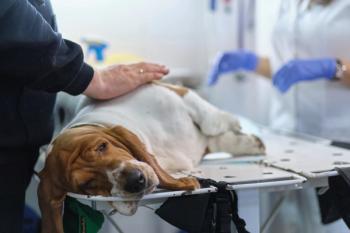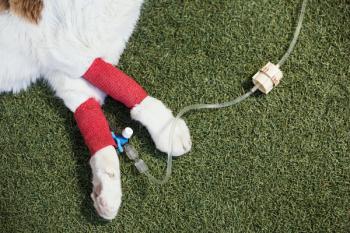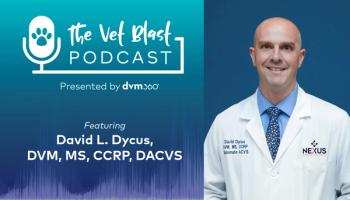
Dental extractions: Easy cues help with critical long-term medical decisions
Dental extractions are among the more common veterinary dental procedures. With that said, there are key considerations every veterinarian must consider before an extraction is performed. This article explores the options.
Dental extractions are among the more common veterinary dental procedures. With that said, there are key considerations every veterinarian must consider before an extraction is performed. This article explores the options.
1. Think of the pet first and discuss options with your client.
As a small animal practitioner, your practice mission statement probably communicates your dedication to providing optimal patient care. Dental extractions are often the best treatment option and at times the only option. What are the indications for dental extractions? The answer aligns with your mission statement as you think about the pet first. An acronym "PET FIRST" summarizes the major indications for dental extractions.
- P = periodontal disease, especially with cases suffering from greater than 50 percent bone loss, often requires extraction.
- E = endodontic disease or non-vital teeth may be extracted.
- T = traumatic occlusion can cause injury to other teeth or periodontal tissues.
- F= fractured teeth, especially having pulp exposure, may require extraction.
- I = immunologic problems with plaque bacteria as antigens could signal an indication of extraction.
- R = resorptive lesions of teeth are often painful, and extraction is indicated.
- S = stomatitis is particularly common in cats and may best be treated by extraction.
- T = traumatic fractures resulting in teeth in the fracture line might need to be removed.
Additional indications for extraction include teeth that have not erupted, persistent deciduous teeth or retained root fragments.
Client communication is essential in obtaining informed consent and minimizes the risk of misunderstandings. Always provide treatment options, cost estimates and potential risks before proceeding into dental procedures. Clients appreciate options and involvement in deciding how to proceed in their pets' care. They appreciate your caring attitude in referral to a specialist to save, rather than extract teeth. Strategic teeth, such as the canines and the carnassials (upper-fourth premolar and lower molars) are especially important for function and should be saved if possible. To find a veterinary dental specialist for consultation or referral, go to
2. Operators performing dental extractions need both "drills" and appropriate skills.
If the diagnosis and your client's desires warrant dental extraction, it becomes simple to determine if you should extract that tooth. Do you have the interest, skill, equipment and proper instrumentation? For those that have all the requirements, enjoy the benefits of oral surgery and the client appreciation that results from these procedures. If there is no interest, delegation to an associate or referral are logical options. Numerous opportunities exist for continuing education. At most major meetings, the required training, equipment and instruments are available. Do you have the "DRILLS"? Yes, it's another easy-to-remember acronym.
- D = dental unit. Remember that high-speed, low-speed and air-water irrigation are essential components.
- R = radiography (intraoral) capability is essential in performing dental extractions.
- I = instruments should be available as a wide variety are needed to accommodate patient needs.
- L = lighting with magnification aids in dental extraction procedures.
- L = location of the dental suite should prevent distractions.
- S = suction is very beneficial during dental extraction procedures.
The dental operatory should be well organized and preferably isolated from distracting activities (such as the general treatment area). This allows the operator to focus on the dental procedure. A dental unit should include high- and low-speed handpieces with an air-water syringe for irrigation. High-speed headpieces with fiberoptics or overhead surgical lighting, along with magnification (operating telescopes) and suction, optimize visualization of the surgical field.
The operatory also should include a dental radiograph machine. Intraoral radiographs should be taken to help in planning for dental extractions. These radiographs are of high detail and superior to skull films. They are useful for diagnosis, treatment planning, intra-operative orientation and to document completion of the procedure. Intraoral radiographs are valuable particularly for evaluation of the root anatomy. Curved (dilacerated, Photo 1), ankylosed, supernumary, fractured, retained root tips and other root anomalies may create tremendous difficulty and surgical complication, without radiographs. Failure to take radiographs before extractions is malpractice. (Benjamin Colmery III, The gold standard of veterinary oral healthcare. In: Vet Clinics of North America, Small Animal Practice; Dentistry. Guest Editor; S.E. Holmstrom. July 2005, 35(4) p. 783.)
Species and patient-size variation necessitate a variety of well-maintained instruments for dental extractions. A selection of scalpel blades (the author prefers #12, 15 and 15-C) with round scalpel handles (Photo 2), periosteal elevators, dental elevators, luxators (Photo 3), extraction forceps, root-tip picks, needle holders (preferred Castrovejo), and a variety of surgical scissors [preferred Iris, LaGrange (Photo 4), Metzenbaum and suture] are particularly useful.
3. Do you understand the "FACTS" necessary for performing dental extractions?
Follow along in this step-by-step discussion of the "FACTS" on dental extractions.
- F = flaps are planned to facilitate the initial root exposure, a tension-free closure of the final surgical defect and to maximize blood supply for optimal healing.
- A = alveoplasty is performed to identify roots, periodontal ligament tissue, furcations and to reduce tooth anchorage to the alveolar bone.
- C = crown sectioning allows for individual root luxation, elevation and removal.
- T = thorough curetting of alveolus (alveoli) and trimming flap edges facilitates primary healing of sutured flaps.
- S = suture closure of all dental extractions is mandatory.
Dental radiography with a thorough oral exam are essential elements (Photos 5, 6, pre-operative X-ray) in establishing a diagnosis and treatment plan. Radiographs demonstrate which tooth or teeth should be removed. This allows for optimal planning of the flap. A well-planned flap allows for excellent root exposure, minimal trauma and optimal patient healing.
Mucogingival flaps are designed to maximize blood supply. Circumferential sulcular incisions to the crestal bone (preferred #15-C blade on a round handle) establish the coronal margin of the flap. The interproximal papillae are intentionally preserved. If one or more releasing incisions are planned, they begin coronally at a line angle (peripheral edge of tooth) and extend past the mucogingival line (Photo 7) to allow adequate flap mobilization and tooth exposure. A single mesial, vertical release incision is ideal for most flaps, however to allow for additional exposure, a second distal, vertical release incision might be helpful. Alternately, an envelope flap with no releasing incisions can be used. Each case necessitates pre-planning for the optimal flap design. Meticulous attention to avoid neurovascular structures is necessary when making any releasing incisions. This will minimize hemorrhage, potential inflammation, infection and avoid patient injury.
A periosteal elevator (preferred Molt #5, Photo 8) is used to elevate the mucosa and periosteum from the alveolar bone (Photo 9) and to protect the flap from injury during the extraction procedure. All soft tissues are handled gently (atraumatic forceps are preferred) and maintained moist. Throughout the procedure, direct digital pressure is applied to minimize hemorrhage.
Alveoplasty and sectioning of multi-rooted teeth simplify dental extractions. Alveoplasty allows for greater exposure of the root, periodontal ligament and furcations. A #2 round bur in the high-speed handpiece is used to carefully remove 20 to 40 percent of lateral (buccal) bone. In multi-root teeth, crown sectioning (Photo 10), beginning at the furcation(s) and extending through the crown, allow for isolation of roots and easier extraction. A cross-cut tapered fissure (preferred # 699-L, # 701 or # 701L) bur in a high-speed handpiece facilitates tooth sectioning. Liberal irrigation is mandatory during alveoplasty and tooth sectioning to minimize infection and to avoid patient injury. Schematic drawings, models or reference textbooks should be available for proper orientation.
Individual roots are circumferentially luxated and elevated for complete removal.
Gentle, deliberate force
These procedures involve controlled, gentle and deliberate force. Please exercise caution to avoid instrument slippage and injury to the patient or yourself! Luxation partially severs the periodontal ligament from the root and alveolar bone. A round bur (preferred #1/4) may be used in the periodontal ligament space (the area between the root and alveolus) to improve access for the luxators and elevators. A luxator is a sharp, thin instrument used as a wedge (exercise caution to avoid breakage and injury), it should never be rotated. (Holmstrom S, Frost P and Eisner E. Exodontics. In: Veterinary Dental Techniques for the Small Animal Practitioner 2nd ed W.B. Saunders Co., 1998: 220-221.)
The root is then elevated using a dental elevator that will maximize surface area in contact with the root. Gently apply rotational force and hold; this separates the remaining periodontal ligament attachments.
The elevator should never be used in a back and forth repetitive twisting motion (like a screw driver) to avoid tooth fracture or patient injury. The root is then removed from the alveolus using an extraction forceps that maximizes contact with the tooth (Photo 11). The forceps is used to lift the tooth root out of the alveolus. If it is used to forcefully "pull the tooth", instrument slippage, root fracture or patient injury are likely.
Closure
In preparing for flap closure, examine the alveoli for sharp edges. Smooth any sharp edges using a #2 bur in a high-speed handpiece with irrigation. Using direct illumination with magnification, examine the alveolus for fractures, debris, tooth or bony fragments (Photo 12). Thoroughly curette the alveolus (Photo 13) and trim all mucogingival flap edges (Photo 14). Examine the root apex (Photo 15) for smoothness, and take a final radiograph (Photo 16, post-op X-ray) to verify the root has been entirely removed.
Periosteal releasing incisions along the base of the flap will substantially reduce flap tension (Photo 17). Evaluate the flap to ensure there are no tears and that it will accommodate a tension-free closure of the entire surgical defect. Suture the flap using a simple interrupted suture pattern of a resorbable suture material (preferred 4-0 or 5-0 Monocryl).
This author prefers to remove the entire root structure in cats and dogs, provided the procedure does not create unusual risk to the patient. If roots fracture and are not retrieved, the client must be notified and the patient followed radiographically for periapical disease. Pain, swelling, inflammation or draining tracks in areas with retained root tips must be addressed. These cases should be referred to a specialist if the operator lacks appropriate equipment, training or skill to correct the problem.
4. Our communication and their pet's appearance, dramatically influence client perceptions.
Written instructions should be sent home to summarize your home-care directions. Surgical extraction patients receive analgesics for three to seven days post-operatively (preferred tramadol and possibly a non-steroidal anti-inflammatory). Antibiotic therapy might be indicated in specific cases. Chlorhexadine rinses or zinc gluconate gels (Maxi/Guard) may be used to help keep surgical sites clean. Hard-chewing objects are discouraged, and soft food is encouraged for 10 days. A two-week re-evaluation of the patient for healing is very important and demonstrates that you care. Flap dehiscence is painful and should be addressed immediately if it occurs. The recheck exam is a "value-added" step for the client and a "quality-control" procedure for your dental service.
Your practice mission statement is realized by your clients when they pick up their companion after oral surgery. They quickly understand your dedication to providing optimal patient care, when they see their pain-free pet with a wagging tail. A positive perception of value has been solidified. Your effort to prove that you do think of their companion first has been a success.
Accurate diagnosis, honest discussion of treatment options, developing dental skills, well-planned extractions, a clear understanding of the acronyms DRILLS, FACTS and keeping the PET FIRST is how we deliver our mission statement for optimal patient care.
Dr. Kressin, a diplomate of the American Veterinary Dental College, operates a specialty dental and oral surgery service in Oshkosh and Milwaukee, Wis. He is a fellow of the Academy of Veterinary Dentistry.
Newsletter
From exam room tips to practice management insights, get trusted veterinary news delivered straight to your inbox—subscribe to dvm360.




